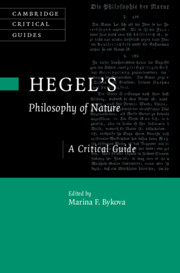Book contents
- Hegel’s Philosophy of Nature
- Cambridge Critical Guides
- Hegel’s Philosophy of Nature
- Copyright page
- Dedication
- Contents
- Contributors
- Acknowledgments
- Abbreviations
- Hegel’s Philosophy of Nature
- Part I Hegel’s Philosophy of Nature in the Historical and Systematic Context
- Part II Cosmology, Mechanics, and Physics
- Chapter 6 Hegel’s Dissertation on the Orbits of the Planets
- Chapter 7 Hegel’s Syllogism of Analogy and Organic Conception of Cosmic Life
- Chapter 8 Hegel’s Mechanics as a System of Steps from Space and Time to Celestial Motion
- Chapter 9 Logic and Physics in Hegel’s Philosophy of Nature
- Part III Organics
- Part IV On Contemporary Challenges for the Philosophy of Nature
- Bibliography
- Index
- Cambridge Critical Guides
Chapter 8 - Hegel’s Mechanics as a System of Steps from Space and Time to Celestial Motion
from Part II - Cosmology, Mechanics, and Physics
Published online by Cambridge University Press: 19 December 2024
- Hegel’s Philosophy of Nature
- Cambridge Critical Guides
- Hegel’s Philosophy of Nature
- Copyright page
- Dedication
- Contents
- Contributors
- Acknowledgments
- Abbreviations
- Hegel’s Philosophy of Nature
- Part I Hegel’s Philosophy of Nature in the Historical and Systematic Context
- Part II Cosmology, Mechanics, and Physics
- Chapter 6 Hegel’s Dissertation on the Orbits of the Planets
- Chapter 7 Hegel’s Syllogism of Analogy and Organic Conception of Cosmic Life
- Chapter 8 Hegel’s Mechanics as a System of Steps from Space and Time to Celestial Motion
- Chapter 9 Logic and Physics in Hegel’s Philosophy of Nature
- Part III Organics
- Part IV On Contemporary Challenges for the Philosophy of Nature
- Bibliography
- Index
- Cambridge Critical Guides
Summary
This chapter discusses the sections of finite and absolute mechanics of Hegel’s Philosophy of Nature which are predicated upon his theory of space and time. It starts with the emergent notions of matter and movement before giving the details of the mechanical analysis in a close reading. Giving a foundation for Kepler’s laws is not only a touchstone of Hegel’s theory but is an integral rung in a system of steps building natural science from space and time. The chapter exposes three main strands of argument: dimensional realization of time and space in movement of matter, striving towards inner and outer centers of extended bodies, and the realization of a system of bodies in motion which materializes a complexity paralleling not only of the tripartite system general-particular-individual of his logic but additionally includes two particulars – as necessary in Hegel’s account of nature. Lastly, the chapter comments briefly on the relationship to Kant, Newton, and classical mechanics, as well as on modern aspects. As it demonstrates, Hegel’s treatment of mechanics is not an idiosyncratic way of presenting celestial mechanics but contains radical, quite modern metaphysical concepts which are not only interesting in their own right but furnish a key to the understanding of his system.
- Type
- Chapter
- Information
- Hegel's Philosophy of NatureA Critical Guide, pp. 158 - 175Publisher: Cambridge University PressPrint publication year: 2024

